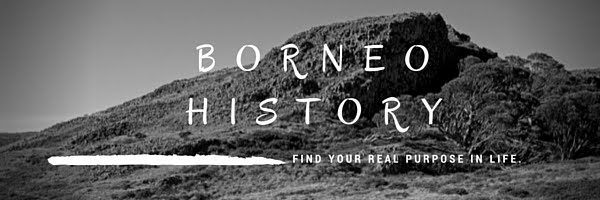The Timogun Murut, The Legend of Tampulan and The Tampulan's
Stone.
The Murut comprise several people groups that are scattered
in parts of Borneo Island including Brunei, Kalimantan (Indonesia), and the
East Malaysian states of Sabah and Sarawak.
Their largest numbers are in Sabah but some also inhabit the
rural Temburong District in Brunei. They were among the last tribal groups on
Borneo to renounce headhunting.
The largest Murut people groups are Tagal, Tidung, Timugon,
Sembakung, Paluan, Bookan, Kalabakan, and Serundung Murut. The Sabah Murut
population is around 135,000 while around 1,200 are found in Brunei.
The literal meaning for Murut is 'hill people'. The Murut
were formerly shifting cultivators moving their settlements every few years. Each
people group has their own dialect, but most are also conversant in Malay which
is the national language in Brunei and Malaysia.
The main branch of the Timogun people lived on the plains at
Tenom,which boarder the Padas and Pegalan River, hence their name "The
People of the River" (Timog-River). Their district there extended roughly
from the Kwala Sapi, Padas, beyond Sapong, about the 9th mile on the old road
to Kemabong, to Melalap, Pegalan, at the northern end of the plain, about mile
10 on the Keningau Road.
 |
| Tampulan Stone, Melalap, Tenom |
 |
| Tampulan Stone, Melalap, Tenom |
 |
| Tampulan Stone, Melalap, Tenom |
 |
| Batu Belanoi |
 |
| Batu Belanoi |
 |
| Timogun Longhouse |
In one of his journals, when he was staying at the northern
end of the Tenom plain, Mr. Witti wrote "At another such clearing there is
a stone block on which the division of skulls is made: these Dyaks are said
never to go beyond quartering a head, smaller shares being made up in kind. On
that block could be seen the stains of blood. Nearby is a rude scaffolding
which serves to exhibit the trophies. But the queerest feature of that spot was
a young sugar plant sprinkled with blood and carefully fenced in - why not a forget me-not?"
He does not mention the name of the clearing, but it is
probably a reference to Batu Tampulan -'Tampulan's Stone near Melalap. The
sugar plant is no longer there , the surrounding jungle is gone and rubber
trees have taken its place, but the stone is still there, though the blood
stains have long since been washed away.
It is a large flat stone slab, roughly circular in shape,
about three feet in diameter and apparently not more than six inches or so in
thickness ; close by are two or three ordinary looking boulders, and a yard
from it another stone which may be a flake from a round boulder ; it stands
about two feet high; about a foot wide at ground level rising to a point which
is curved over towards the flat block-it reminds one of a cobra head and is
said to be a man who was turned into stone whilst squatting down with his eyes
fixed on the trophies lying on the block.
A few hundred yards away is another stone, 'Batu Belanoi', a
small cone two feet high with a circular depression on the tip of the cone,
said to have been made by Tampulan, who used it as seat and wore away its top.
Tampulan was a Timogun hero of ancient times. One day, when
he was a child and had been left alone in the house by his parents, a Spirit
came and carried him off into the top of a tall Aru tree where he kept him and
instructed him in the use of weapons and in all kinds of wisdom and in magic.
For several months he lived in the tree top and finally was restored by the
Spirit to his parents who had searched for him in vain all over the country.
Tampulan grew up a wise leader of his people and a mighty
man of war. He built a great 'Longhouse' Village called Dapulan for himself
and his people, and the flat stone was his hearthstone.
One day a party of Peluans from Bokan District in Ulu Sook
came down to raid Kasai, a Timogun house not far from Dapulan; the news reached
Tampulan who seized his weapons and with a single leap sprang from his own
house to Kasai and attacked the enemy: with every stroke a Peluan fell, and in
few minutes not a single raider was left alive. He collected the heads and took
them home and made a great feast over them.
Not Long afterwards, he set out on a lone raid up the Sook
valley and in the Bokan Country found a large party planting padi on hill side
clearing; he muttered some charms and stroked his hand down his blowpipe, and
transformed himself into the likeness of old Bokan with along planting stick in
his hand. Thus disguised he joined the unsuspecting planters, and when in the
midst of them once more stroked his staff which became again a spear tipped
blowpipe, and with quick stabs right and left he slew everyone on the planting
party.
As he was making off with the heads, help arrived, too late,
and pursuit was vain, for Tampulan leaped to the tree top of the jungle to
Dapulan, where he cleaned and prepared the skulls on his hearthstone. His fame
was never forgotten, and after his death his people always assembled round the
stone after a successful raid and there cleaned their trophies and divided his
share to every warrior who borne a part in the attack.
G.C.W.
Edited by :
Kumis Kumis
Source :
1. The British North Borneo Herald dated 16th April 1936
2. The Timogun Murut of Sabah - GC Whoolley 1936
3. Diary of F Witti, 1882
Photos :
The National Archives UK - circa
1920s-1930s (CO 1069/538)
